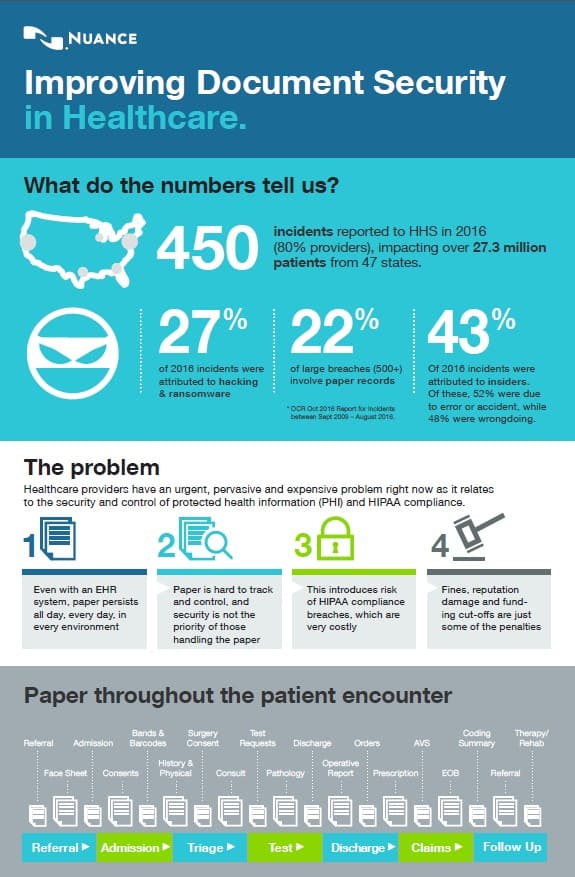By Chris Click
Sr. Healthcare Solutions Marketing Manager for Nuance Document Imaging
Data breaches in the healthcare industry are common and carry risks for both patients and providers. Commonly, data breaches are the result of accidents or errors rather than nefarious hackers.
 Today, most hospitals, clinics and healthcare organizations continue to receive and process high volumes of information through paper. Sensitive information oftentimes is transferred from hard copy to digital formats numerous times, and these transfers introduce heightened risk. This is especially true for important documents such as medical records, prescriptions and admissions documents.
Today, most hospitals, clinics and healthcare organizations continue to receive and process high volumes of information through paper. Sensitive information oftentimes is transferred from hard copy to digital formats numerous times, and these transfers introduce heightened risk. This is especially true for important documents such as medical records, prescriptions and admissions documents.
When taking steps to protect data security, healthcare providers shouldn’t overlook documents that transition between paper and digital formats during their life cycle. In particular, those transition points, such as document scanning and printing, can introduce risk.
There are numerous activities that healthcare professionals can do during different touch points throughout their day that expose their organization to potential data leaks.
Admissions & Discharges
Manual data collection processes during admissions and discharges can increase the occurrence of human error. Having a clear data capturing process will allow information to be collected efficiently and securely. This will lower the risk of non-compliance and establishes an added layer of security for sensitive information.
Point of Care
Electronic health records (EHRs) can at times be frustrating to use. Tapping the full capabilities of EHRs will keep patient information safe and accessible only to authorized personnel. Enabling all privacy, encryption, access control and password protection features to their full potential will ensure peace of mind for physicians.
Exchange of Patient Health Information (PHI)
The many touch points in the creation, use and sharing of PHI invite the risk of human error or bad intent. For example, hospital staff will often do what they think it takes to get their jobs done, such as sending documents or pictures to themselves from their cell phones, even if it is not compliant. Healthcare organizations need to conduct a risk assessment to identify threats and vulnerabilities, implement and train workers in data loss protection technology and procedures, and establish security incident reporting.
Chris Click is the Sr. Healthcare Solutions Marketing Manager for Nuance Document Imaging, where he is responsible for driving the worldwide print and capture marketing strategy for the division’s healthcare solutions. Prior to his current role, Chris worked as the Nuance Healthcare Division solutions marketing director and previously headed up sales and marketing at Client Outlook Inc. a provider of healthcare enterprise imaging applications sold through a global partner network. Chris graduated with B.S. in Computer Science from Dallas Baptist University.



 Janine Anthes
Janine Anthes